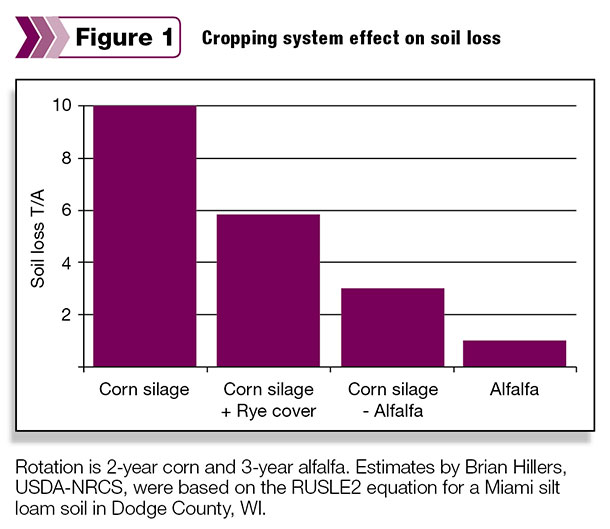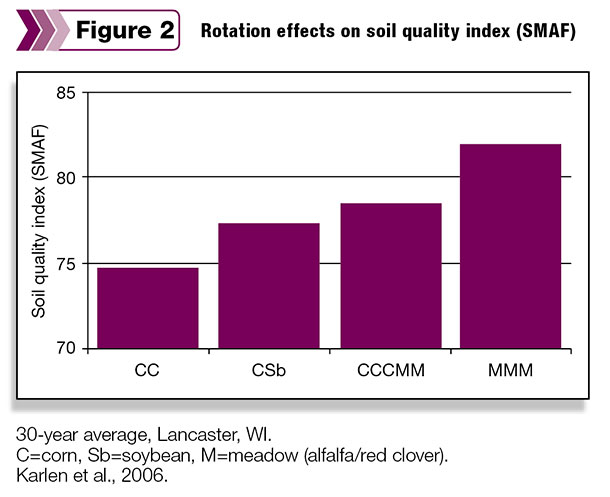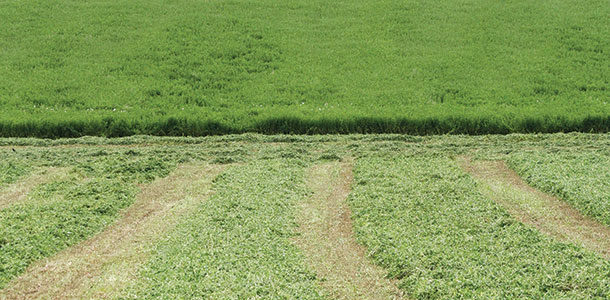But alfalfa acreage has been declining steadily for the past 50 years, while the acreage of soybeans and, more recently, corn has been increasing.
One of the reasons for the increase in corn acreage and decrease in alfalfa acreage is that the amount of corn silage fed to U.S. dairy herds has increased significantly in the last 20 years.
This shift from alfalfa to corn silage has been attributed to factors such as higher yield and energy per acre from corn silage, simpler (annual) harvest management, high rumen degradability of alfalfa protein and better opportunities for manure management with corn.
There are, however, a number of economic and environmental benefits from production of alfalfa and other perennial forages that are sometimes overlooked when comparing them to silage corn.
One of the most important and well-understood economic reasons to incorporate perennial forages into a rotation is the nitrogen (N) credit for the crop following the forage.
Nitrogen released from decomposing alfalfa tissue and from newly accumulated soil organic matter can supply most or the entire N requirement of a following corn crop.
In addition, first-year corn grown after alfalfa may have 10 to 15 percent higher yield potential due to factors other than N supply (“rotation effect”), including improved soil tilth and fewer pest problems.
Because of lower insect pressure, additional savings can be had in seed or insecticide with corn rotated after perennial forage.
Erosion control
While N credits and the rotation effect are measurable and provide short-term economic benefits, perennial forages also have more long-term benefits on water quality and soil health.
A major concern with corn silage production is the increased risk of soil erosion when there is little residue to protect the soil surface. Erosion can be greatly reduced by incorporating alfalfa into the rotation.

An example from southern Wisconsin shows that soil erosion can be reduced to 3 tons per acre soil loss in a corn silage-alfalfa rotation, compared to 10 tons per acre with continuous corn silage (Figure 1).
Erosion also can be reduced with a winter cover crop after corn silage, but not as much as with a perennial crop.
Decreasing soil erosion helps protect surface water from sediment, one of the most frequently cited impairments of water quality. In addition, most phosphorus (P) lost in surface runoff from row-crop systems is associated with eroded sediment, so incorporating more alfalfa into rotations can also decrease P loss in the runoff.
Both sediment and P impair habitat for high-value fish species, and excessive P can increase algae growth, leading to water quality degradation and fish kills.
Producers should be aware, however, that significant soil erosion and associated P loss can occur from tilled soil during establishment of perennial forages, and that dissolved P can be present in runoff from freeze-damaged forage. To mitigate this loss:
- Reduce erosion during establishment by including a companion small grain or forage grass.
- Reduce runoff of dissolved P by harvesting regrowth in late fall.
Organic matter
Much of the benefit in controlling erosion is derived from the year-round vegetative cover perennial forages provide, but another important factor is increased accumulation of soil organic matter compared to annual cropping.
Soil organic matter reduces erosion by improving aggregate stability and water infiltration and minimizing soil crusting and surface sealing.
Soil organic matter is also a central factor in overall soil quality, or soil health. Organic matter plays a key role in a range of soil properties, including water-holding capacity, aeration, aggregate stability, nutrient-supplying capability and microbial activity. All of these are important for crop production and overall soil health.
Perennial forages increase soil organic matter content compared to annual grain cropping in two different ways. The rate of organic matter decomposition is lower because the soil is not disturbed or tilled each year (which also occurs to some extent with no-till crop production).
And the extensive roots of perennial forages, a portion of which die each year, add organic matter to the soil and provide an energy source for micro-organisms and aid in soil aggregation.
Several field trials in Iowa and Wisconsin documented increased soil organic matter, soil aggregate stability and microbial biomass in perennial forage or corn-perennial forage systems compared to continuous corn.
The composite effects on physical, chemical and biological soil properties can be estimated by calculation of a soil quality index. One such index, the Soil Management Assessment Framework (SMAF), incorporates several soil characteristics, including bulk density, water-stable aggregates, organic matter, extractable P, pH and microbial biomass carbon.

Legume and grass forages improve the SMAF soil quality index, both as rotation crops (Figure 2) and as companion crops or cover crops, compared to continuous corn.
Nitrate leaching
Another environmental concern is the leaching of nitrate into subsurface tile drains. Land seeded with alfalfa or Conservation Reserve Program vegetation in Minnesota had lower tile line discharge and negligible nitrate-N loss (less than 5 pounds N per acre) compared to continuous corn or a corn-soybean rotation (30 to 80 pounds N per acre). Planting grass or alfalfa “waterways” directly over tile lines also can reduce nitrate losses.
Manure utilization
What about manure on perennial forages? Land in perennial forages provides opportunity for manure application during mid-season when land in annual crops is not available.
Manure can supply needed nutrients – potassium, P, sulfur, micronutrients and N (for non-legumes). Large nutrient removal in the harvested forage helps with nutrient balance and minimizes nitrate leaching.
These advantages to manure application on forages need to be considered in the context of some potential concerns – plant damage from manure or wheel traffic, pathogen transmission in the feed, nutrient runoff and excessive N at stand termination where there already is a large N credit.
Added benefits
Other benefits of alfalfa and other perennial forages in rotation with corn include better distribution of labor needs and improved wildlife habitat. For grain producers who do not want to purchase a new line of equipment, contract planting and harvesting often is available.
And on top of all these benefits, alfalfa also helps even out net farm income. For example, in 2013, net return over labor and management for alfalfa in southwestern Minnesota was more than double that for corn grain.
The fact that forages also can produce substantial direct and indirect economic returns should make the decision to include more forages in the rotation an easy one. FG
Michael Russelle is a research soil scientist with the USDA-Agricultural Research Service, U.S. Dairy Forage Research Center.
References omitted due to space but are available upon request. Click here to email an editor.
PHOTO
Photo by FG staff.

- Bill Jokela
- Research Soil Scientist - USDA-Agricultural Research Service
- U.S. Dairy Forage Research Center











